People around the world III
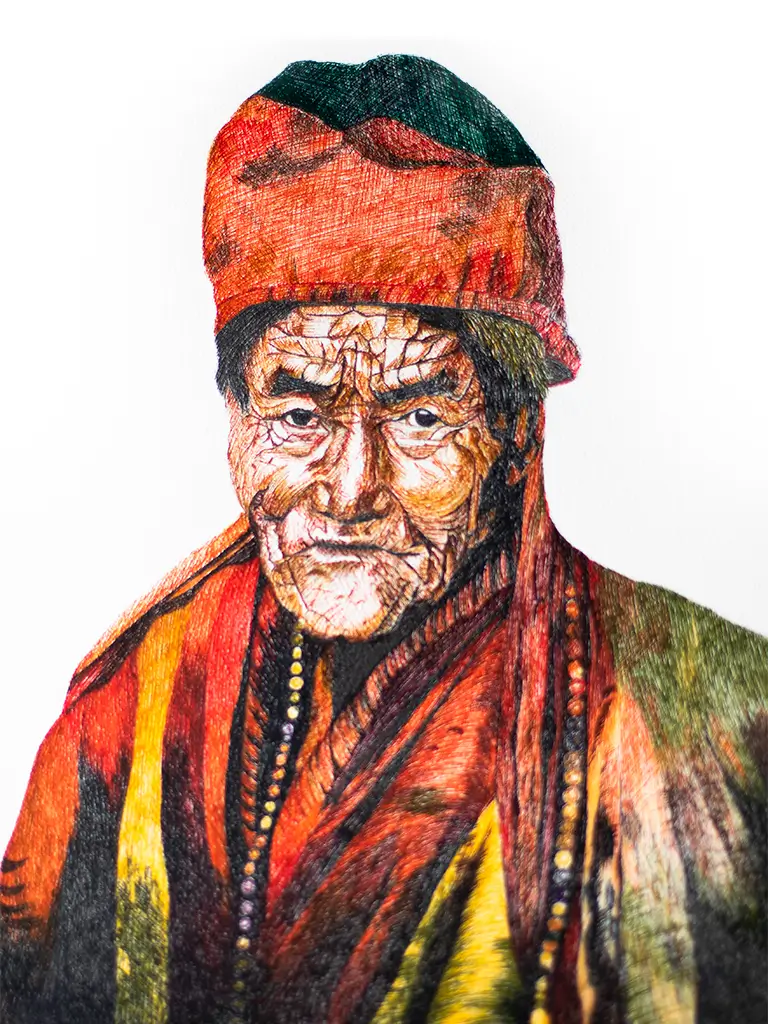
The third portrait in the series shows a woman with a deeply wrinkled face, with the serene dignity of someone who has lived intensely. She wears a voluminous turban and a brightly coloured robe that spills out in rich, expressive folds. A necklace of irregular beads rests on his chest, as if it were just another part of his story. Her appearance suggests South or East Asian roots: India, Thailand, perhaps Mongolia… it doesn’t matter where exactly, but what her face conveys.
The pen stroke, firm and uncorrected, finds in her wrinkles a map of experiences. Each line on the skin is a furrow of time, and each shadow, a story. The colour, vibrant but restrained, gives life to the fabrics, to the brightness of the necklace, to the contrast between the vitality of the outfit and the silent gravity of her expression.
She does not smile or pose. She simply is. She looks straight ahead, with an intensity that does not seek to impose itself, but says it all. Her presence closes the series with a quiet strength, like a root that supports the whole.
Together with the other two portraits – the man with the grey hair and the man in the Arab turban – this figure completes the balance of the series: three faces, three geographies, three different silences, united by the same human gaze.
Pen and colour here become tools of respect, of listening, of attention to the real. It is not a portrait of the exotic, but of the essential.
People around the world II

The second portrait in this series presents the figure of a man wrapped in a light robe and a carefully knotted turban, revealing an identity that evokes the Arab world, at once ancestral and contemporary. His face, serene and silent, seems to look beyond the viewer, as if in dialogue with something we do not see.
The pen firmly traces the lines of expression, the contours of the face, the texture of the canvas. There is no artifice, only the truth contained in each fold, in the way the light rests on the forehead or slides along the edge of the turban. The colours, subtle and measured, accompany the depth of the gesture: ochres, soft earths, touches of bluish shade that envelop the figure in a warm, almost sacred atmosphere.
This portrait, like the other two in the series, does not seek a literal or ethnographic representation. Its strength lies in the gaze, in the restrained attitude, in what is conveyed without words. It is a face that speaks of tradition, of belonging, but also of shared humanity: something that transcends borders and eras.
In the whole, this second painting brings balance and contrast. In contrast to the rebellious hair of the first portrait, here there is withdrawal. Against the questioning gesture of another face, here there is pause. Three faces, three ways of inhabiting the world.
People around the world I
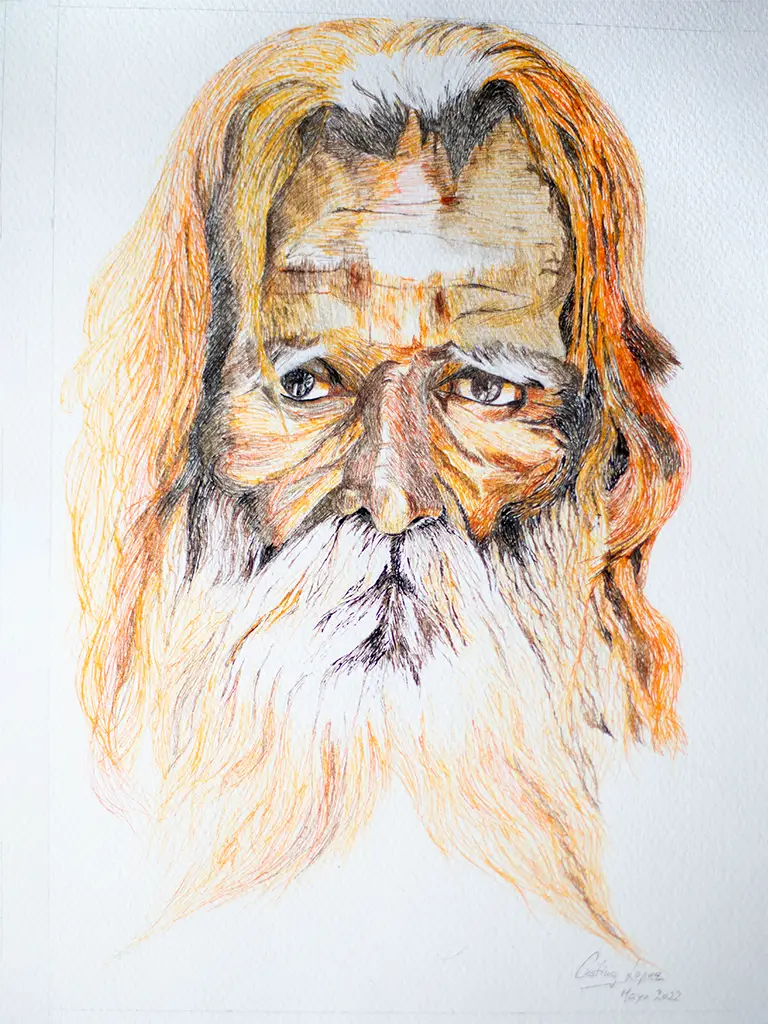
This series of three colour works, executed with biros, is an intimate study of the human in its diversity and depth. Each portrait captures a different face, a particular energy, united by the same technique that combines the immediacy of the pen with the sensitivity of colour applied with restraint and decision.
One of the paintings portrays an Indian man with an intense gaze and abundant, almost wild, grey hair. His hair is not just a physical feature, but a presence, a symbol of identity, of history, of belonging. The pen precisely details the folds of the face, while the colour brings warmth, highlights the contrast between the skin and the hair, and lets the background breathe with a subtly charged atmosphere.
The other two pieces complete the set: different faces, different silences. One perhaps more serene, the other more defiant, but all traversed by the same intention: to capture the invisible. The emotion beneath the surface. The instant suspended between what is seen and what is sensed.
It is not a series about specific characters, but about what they have in common: the imprint of time, the strength of expression, the dignity that emanates from the real. The pen, with its definitive stroke, forces us to look carefully; the colour, with its fragility, reminds us that there is beauty even in the unfinished.
Three paintings. Three faces. A single voice.
Unknown III
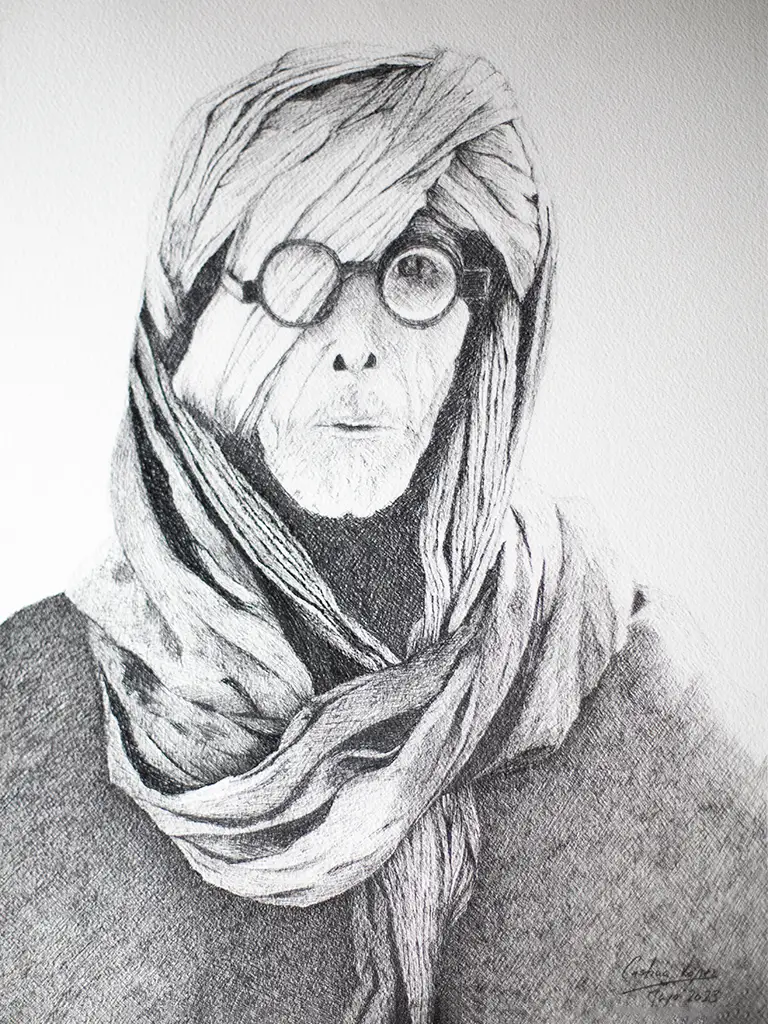
This portrait, painted with marker and pencil – and in some strokes, with biros – depicts the face of an older man wearing glasses and a turban, enveloped in a serene, almost meditative expression. The work, in black and white, renounces colour to focus on the essential: the time inscribed in the folds of the face, the depth of the gaze, the texture of a life.
The technique combines fine lines with areas of shadow constructed from crossed layers. The pen gives a particular density, almost metallic, while the felt-tip pen defines contours and gives weight to the dark areas. The pencil softens, connects, breathes between contrasts. Together, these tools construct not only a figure, but a presence.
The turban, more than an accessory, is a symbol of identity, wisdom and tradition. The glasses frame eyes that look not directly, but inwards, as if they were remembering rather than observing. There is no drama, only dignity.
This drawing is not meant to idealise, but to honour. It is a portrait of humanity, of memory, of roots. Of someone who, although we do not know by name, we feel close to, as if their story – silent, drawn line by line – also spoke a little of our own.
The eye of the horse
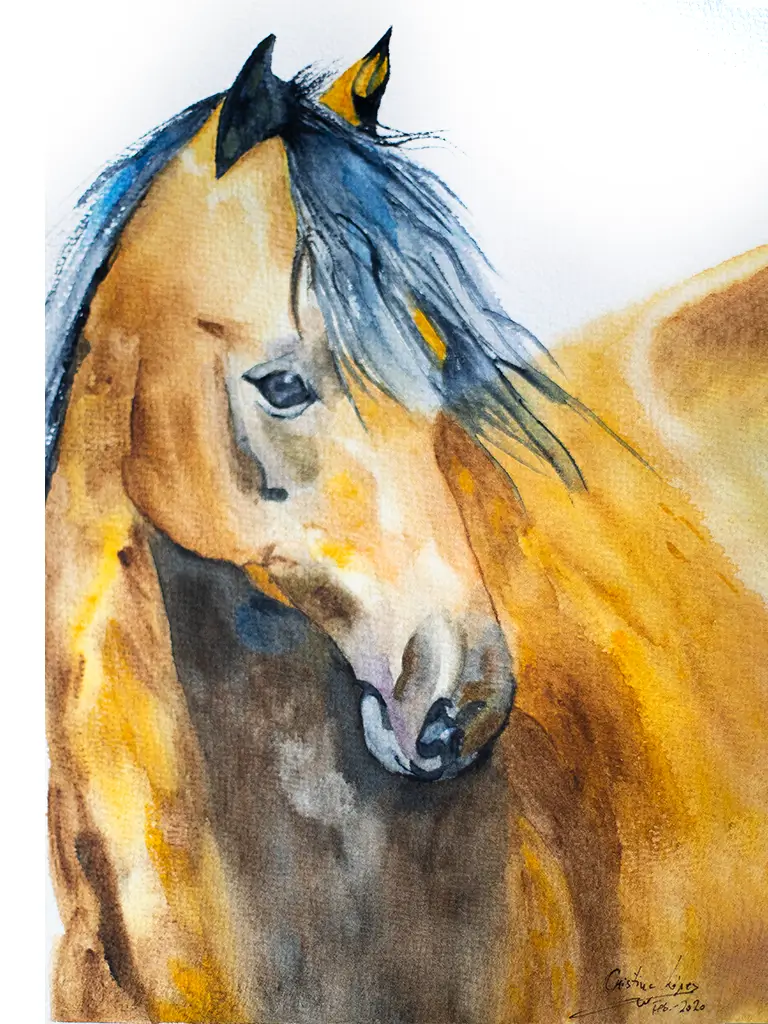
This portrait focuses on the head of a horse, captured in watercolour with a gaze that balances strength with stillness. The choice of watercolour is not accidental: its fluidity allows us to pay homage to the nobility of the animal without enclosing it in rigid lines. The water carries the pigment as the wind caresses the mane – freely, with rhythm, with respect.
Each stroke seeks to suggest rather than define. The soft shadows on the muzzle, the sparkle in the eye, the tufts of hair that blend into the background… everything is worked from transparency, allowing the white of the paper to breathe and give life. It is not a strictly realistic representation, but a presence: that instant when the horse turns its head slightly, hears something in the distance, and everything stops.
This drawing is an invitation to see beyond the form: to connect with the quiet dignity of the animal, with its ancestral memory, its contained power. Because in the silence of its gaze there is something that reminds us of who we were when we still lived close to the land and the animals.
Hummingbird on flower
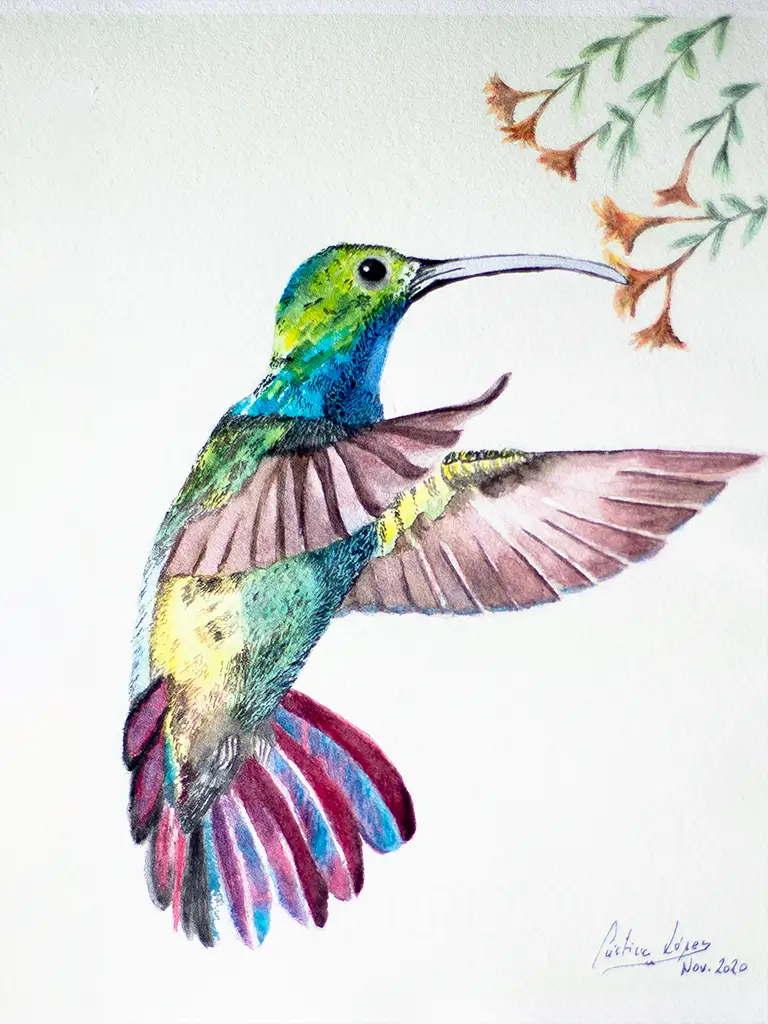
This small drawing captures a fleeting moment: a hummingbird stopped in mid-flight, its beak immersed in a flower. The work is executed in watercolour, ink and coloured marker, a combination that combines the ethereal with the precise. The watercolour brings transparency and movement, evoking the lightness of the air and the speed of fluttering wings. The ink, on the other hand, fixes the structure and gives character to the outline, while the felt-tip pen introduces vibrant, almost electric touches to the feathers and the flower.
Despite its small size, the drawing is full of energy. The hummingbird, a symbol of the ephemeral and the sacred in many cultures, represents here that almost invisible moment that passes before our eyes without our noticing. The gesture of approaching a flower, an everyday occurrence in nature, becomes an almost ceremonial act.
Each stroke was designed so as not to break the delicacy of the moment. The lightness of the water, the speed of the colour, the decisiveness of a line: everything converges to construct not only an image, but a pause.
Because sometimes the smallest thing contains the most intense thing.
Unknown II

This work portrays a young woman wrapped in a white shirt, a simple garment that nevertheless becomes the perfect vehicle for exploring light, transparency and the intimacy of the instant. The technique combines soft pastels and coloured pencil, a mixture that allows for both precise strokes and free gesture, creating a balance between control and spontaneity.
The pastels provide a velvety, almost floating texture that adheres delicately to the paper. The skin tones build layer by layer, revealing the pinks, ochres and lilacs that lie beneath the surface. Coloured pencil is used to accentuate the subtle contours, give definition to the eye and suggest the folds of the shirt, without harshening the overall softness of the drawing.
What lies behind this portrait is not just a female figure, but a restrained atmosphere. She does not look directly, she does not pose, she simply is. The white shirt is not just clothing, it is a symbol of vulnerability, of emotional cleansing, of an intimate moment in which the person is shown without armour.
More than a figure study, this drawing seeks to capture a suspended emotion, as if time has stopped for a second before something changes.
Unknown I
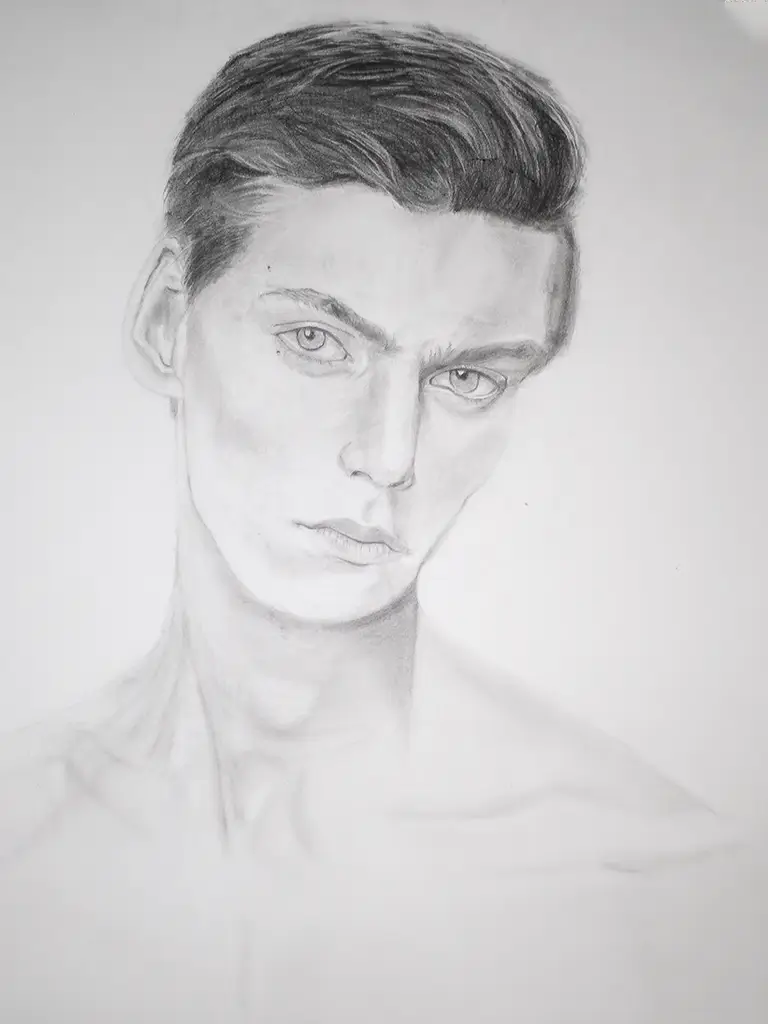
This drawing, made with charcoal on paper, captures the face of a young man whose expression is a mixture of strength and softness. Charcoal, with its ability to create intense contrasts and emotionally charged strokes, allows us to explore both the texture of the skin and the depth of the gaze. Unlike graphite, charcoal does not seek surgical precision, but rather an atmosphere, a feeling that breathes between line and shadow.
The process began with loose, gestural strokes, letting the face emerge little by little from the white void. The technique plays with the ephemeral: smudges, blurring with the fingers, lines that are almost completely erased and others that cling to the paper. Each layer is a decision between what is revealed and what is insinuated.
The figure depicted, with subtly effeminate features, does not respond to a specific ideal, but seeks to question it. What defines masculinity? Where does femininity begin? This face inhabits that in-between space, that terrain where labels are diluted. There is no fixed narrative; only a silent presence that invites us to look without prejudice.
Even the imperfections—accidental smears, fingerprints caught in the medium—are part of the story. They ground the portrait in reality, reminding us that this is not a polished icon, but a human being, captured in a moment of becoming. The drawing resists conclusion. It asks questions rather than offering answers, and in doing so, becomes a mirror for the viewer.
It is not just a portrait. It is an exploration of identity, of presence, of the fragile line between being seen and being understood.